
Welcome to Shenzhen Sing Fung Intelligent Manufacturing Co., Ltd.
E-mail:shaobo@sfi-crf.com
The influence of plasma treatment on the surface hydrophilicity of graphite film
- Categories:Technical Support
- Author:Plasma cleaning machine-CRF plasma plasma equipment-plasma surface treatment machine manufacturer-chengfeng intelligent manufacturing Origin
- Origin:
- Time of issue:2021-07-22
- Views:
(Summary description)The influence of plasma treatment on the surface hydrophilicity of graphite film: Graphite film is a new type of heat dissipation material that has emerged in recent years, and its horizontal direction has an ultra-high thermal conductivity. However, because the graphite film has a layered crystal structure, there is van der Waals force between the layers, which makes the vertical thermal conductivity of the graphite film poor, and even has a certain heat insulation effect, which seriously affects the heat dissipation performance of the graphite film. Graphite film/metal matrix composite materials, by using the excellent thermal conductivity of metal materials, effectively make up for the shortcomings of the graphite film’s poor thermal conductivity in the vertical direction. At present, the main preparation method is to magnetron sputter copper and other metal films on the surface of the graphite film. Or use a rewinder to composite the graphite film, thermal conductive glue and metal materials into a composite shape. The use of magnetron sputtering to prepare graphite film/metal matrix composites is expensive and energy-consuming, making it difficult to achieve large-scale material preparation and continuous production. The graphite film/metal composite heat sink is prepared by a rewinder. Because the metal plate used in this method is thick and the thermal performance of the middle thermal conductive adhesive layer is poor, the heat dissipation performance is seriously affected. Due to the smooth surface and strong hydrophobicity of the graphite film, the interface performance between the graphite film and the metal film is poor, and the bonding force between the graphite film and the metal film is very weak. Therefore, how to improve the hydrophilicity of the graphite film is a key issue to enhance the bonding force between the graphite film and the metal coating. After the graphite film is plasma treated, the surface is etched and oxygen-containing polar groups are introduced. The plasma treatment significantly improves the hydrophilicity of the graphite film surface. Plasma modification only occurs on the surface of the material. It can fully improve the surface properties of the material without changing the inherent properties of the material. It is a simple, clean, efficient, energy-saving and environmentally-friendly surface modification method. The surface of the graphite film before and after plasma treatment contains C and O elements, but according to the molecular structure of the graphite film, it is impossible for the untreated graphite film to contain oxygen. However, the full scan reveals that the graphite film contains trace amounts of oxygen. The graphite film is in the atmosphere before XPS, and impurities or water vapor in the air are adsorbed on the surface of the graphite film, thereby introducing oxygen. After plasma treatment, oxygen-containing functional groups such as hydroxyl and carboxyl groups were introduced, resulting in a significant change in the chemical composition of the graphite film surface. The C atom number fraction decreased from 98.37% before the treatment to 83.13%, and the O atom number fraction was changed from that before the treatment. 1.63% increased to 16.87%, and the O/C content ratio increased from 1.66% before treatment to 20.29%. The introduction of these oxygen-containing groups is one of the reasons for the increased hydrophilicity of the graphite film surface. The peel strength of copper-plated samples decreases with the increase of the contact angle of water droplets on the surface of the graphite film, which can qualitatively indicate that the hydrophilicity of the graphite film surface is better after plasma treatment, and the copper plating layer electrodeposited on the graphite film is more The stronger the bonding force of the substrate. On the graphite film without plasma treatment, the bonding force of the electrodeposited copper coating is very weak. There are two mechanisms by which plasma treatment can improve the bonding force between copper and graphite film. First, plasma treatment of the graphite film will cause a large number of carboxyl and hydroxyl groups on the surface. These oxygen-containing functional groups significantly enhance the hydrophilicity of the graphite film surface. When copper is electrodeposited on the surface of the graphite film, the copper reacts with the oxygen in the carboxyl group or the hydroxyl group to form a Cu-O bond, which can enhance the bonding force between the copper and the substrate. Second, the plasma treatment makes the surface of the graphite film rough, and the surface roughness of the material has a good effect on improving the adhesion of the coating. The bonding force between the graphite film and the copper plating layer can be qualitatively characterized by the hydrophilicity of the graphite film surface. The better the hydrophilicity of the graphite film surface, the stronger the bonding
The influence of plasma treatment on the surface hydrophilicity of graphite film
(Summary description)The influence of plasma treatment on the surface hydrophilicity of graphite film:
Graphite film is a new type of heat dissipation material that has emerged in recent years, and its horizontal direction has an ultra-high thermal conductivity. However, because the graphite film has a layered crystal structure, there is van der Waals force between the layers, which makes the vertical thermal conductivity of the graphite film poor, and even has a certain heat insulation effect, which seriously affects the heat dissipation performance of the graphite film.
Graphite film/metal matrix composite materials, by using the excellent thermal conductivity of metal materials, effectively make up for the shortcomings of the graphite film’s poor thermal conductivity in the vertical direction. At present, the main preparation method is to magnetron sputter copper and other metal films on the surface of the graphite film. Or use a rewinder to composite the graphite film, thermal conductive glue and metal materials into a composite shape.
The use of magnetron sputtering to prepare graphite film/metal matrix composites is expensive and energy-consuming, making it difficult to achieve large-scale material preparation and continuous production. The graphite film/metal composite heat sink is prepared by a rewinder. Because the metal plate used in this method is thick and the thermal performance of the middle thermal conductive adhesive layer is poor, the heat dissipation performance is seriously affected.
Due to the smooth surface and strong hydrophobicity of the graphite film, the interface performance between the graphite film and the metal film is poor, and the bonding force between the graphite film and the metal film is very weak. Therefore, how to improve the hydrophilicity of the graphite film is a key issue to enhance the bonding force between the graphite film and the metal coating.
After the graphite film is plasma treated, the surface is etched and oxygen-containing polar groups are introduced. The plasma treatment significantly improves the hydrophilicity of the graphite film surface.
Plasma modification only occurs on the surface of the material. It can fully improve the surface properties of the material without changing the inherent properties of the material. It is a simple, clean, efficient, energy-saving and environmentally-friendly surface modification method.
The surface of the graphite film before and after plasma treatment contains C and O elements, but according to the molecular structure of the graphite film, it is impossible for the untreated graphite film to contain oxygen. However, the full scan reveals that the graphite film contains trace amounts of oxygen. The graphite film is in the atmosphere before XPS, and impurities or water vapor in the air are adsorbed on the surface of the graphite film, thereby introducing oxygen.
After plasma treatment, oxygen-containing functional groups such as hydroxyl and carboxyl groups were introduced, resulting in a significant change in the chemical composition of the graphite film surface. The C atom number fraction decreased from 98.37% before the treatment to 83.13%, and the O atom number fraction was changed from that before the treatment. 1.63% increased to 16.87%, and the O/C content ratio increased from 1.66% before treatment to 20.29%. The introduction of these oxygen-containing groups is one of the reasons for the increased hydrophilicity of the graphite film surface.
The peel strength of copper-plated samples decreases with the increase of the contact angle of water droplets on the surface of the graphite film, which can qualitatively indicate that the hydrophilicity of the graphite film surface is better after plasma treatment, and the copper plating layer electrodeposited on the graphite film is more The stronger the bonding force of the substrate.
On the graphite film without plasma treatment, the bonding force of the electrodeposited copper coating is very weak.
There are two mechanisms by which plasma treatment can improve the bonding force between copper and graphite film. First, plasma treatment of the graphite film will cause a large number of carboxyl and hydroxyl groups on the surface. These oxygen-containing functional groups significantly enhance the hydrophilicity of the graphite film surface. When copper is electrodeposited on the surface of the graphite film, the copper reacts with the oxygen in the carboxyl group or the hydroxyl group to form a Cu-O bond, which can enhance the bonding force between the copper and the substrate.
Second, the plasma treatment makes the surface of the graphite film rough, and the surface roughness of the material has a good effect on improving the adhesion of the coating.
The bonding force between the graphite film and the copper plating layer can be qualitatively characterized by the hydrophilicity of the graphite film surface. The better the hydrophilicity of the graphite film surface, the stronger the bonding
- Categories:Technical Support
- Author:Plasma cleaning machine-CRF plasma plasma equipment-plasma surface treatment machine manufacturer-chengfeng intelligent manufacturing Origin
- Origin:
- Time of issue:2021-07-22 22:07
- Views:
The influence of plasma treatment on the surface hydrophilicity of graphite film:
Graphite film is a new type of heat dissipation material that has emerged in recent years, and its horizontal direction has an ultra-high thermal conductivity. However, because the graphite film has a layered crystal structure, there is van der Waals force between the layers, which makes the vertical thermal conductivity of the graphite film poor, and even has a certain heat insulation effect, which seriously affects the heat dissipation performance of the graphite film.
 Graphite film/metal matrix composite materials, by using the excellent thermal conductivity of metal materials, effectively make up for the shortcomings of the graphite film’s poor thermal conductivity in the vertical direction. At present, the main preparation method is to magnetron sputter copper and other metal films on the surface of the graphite film. Or use a rewinder to composite the graphite film, thermal conductive glue and metal materials into a composite shape.
Graphite film/metal matrix composite materials, by using the excellent thermal conductivity of metal materials, effectively make up for the shortcomings of the graphite film’s poor thermal conductivity in the vertical direction. At present, the main preparation method is to magnetron sputter copper and other metal films on the surface of the graphite film. Or use a rewinder to composite the graphite film, thermal conductive glue and metal materials into a composite shape.
The use of magnetron sputtering to prepare graphite film/metal matrix composites is expensive and energy-consuming, making it difficult to achieve large-scale material preparation and continuous production. The graphite film/metal composite heat sink is prepared by a rewinder. Because the metal plate used in this method is thick and the thermal performance of the middle thermal conductive adhesive layer is poor, the heat dissipation performance is seriously affected.
Due to the smooth surface and strong hydrophobicity of the graphite film, the interface performance between the graphite film and the metal film is poor, and the bonding force between the graphite film and the metal film is very weak. Therefore, how to improve the hydrophilicity of the graphite film is a key issue to enhance the bonding force between the graphite film and the metal coating.
After the graphite film is plasma treated, the surface is etched and oxygen-containing polar groups are introduced. The plasma treatment significantly improves the hydrophilicity of the graphite film surface.
Plasma modification only occurs on the surface of the material. It can fully improve the surface properties of the material without changing the inherent properties of the material. It is a simple, clean, efficient, energy-saving and environmentally-friendly surface modification method.
The surface of the graphite film before and after plasma treatment contains C and O elements, but according to the molecular structure of the graphite film, it is impossible for the untreated graphite film to contain oxygen. However, the full scan reveals that the graphite film contains trace amounts of oxygen. The graphite film is in the atmosphere before XPS, and impurities or water vapor in the air are adsorbed on the surface of the graphite film, thereby introducing oxygen.
After plasma treatment, oxygen-containing functional groups such as hydroxyl and carboxyl groups were introduced, resulting in a significant change in the chemical composition of the graphite film surface. The C atom number fraction decreased from 98.37% before the treatment to 83.13%, and the O atom number fraction was changed from that before the treatment. 1.63% increased to 16.87%, and the O/C content ratio increased from 1.66% before treatment to 20.29%. The introduction of these oxygen-containing groups is one of the reasons for the increased hydrophilicity of the graphite film surface.
The peel strength of copper-plated samples decreases with the increase of the contact angle of water droplets on the surface of the graphite film, which can qualitatively indicate that the hydrophilicity of the graphite film surface is better after plasma treatment, and the copper plating layer electrodeposited on the graphite film is more The stronger the bonding force of the substrate.
On the graphite film without plasma treatment, the bonding force of the electrodeposited copper coating is very weak.
There are two mechanisms by which plasma treatment can improve the bonding force between copper and graphite film. First, plasma treatment of the graphite film will cause a large number of carboxyl and hydroxyl groups on the surface. These oxygen-containing functional groups significantly enhance the hydrophilicity of the graphite film surface. When copper is electrodeposited on the surface of the graphite film, the copper reacts with the oxygen in the carboxyl group or the hydroxyl group to form a Cu-O bond, which can enhance the bonding force between the copper and the substrate.
Second, the plasma treatment makes the surface of the graphite film rough, and the surface roughness of the material has a good effect on improving the adhesion of the coating.
The bonding force between the graphite film and the copper plating layer can be qualitatively characterized by the hydrophilicity of the graphite film surface. The better the hydrophilicity of the graphite film surface, the stronger the bonding force between it and the copper plating layer.
Scan the QR code to read on your phone

TEL:0755-3367 3020 / 0755-3367 3019

E-mail:sales-sfi@sfi-crf.com

ADD:Mabao Industrial Zone, Huangpu, Baoan District, Shenzhen

















